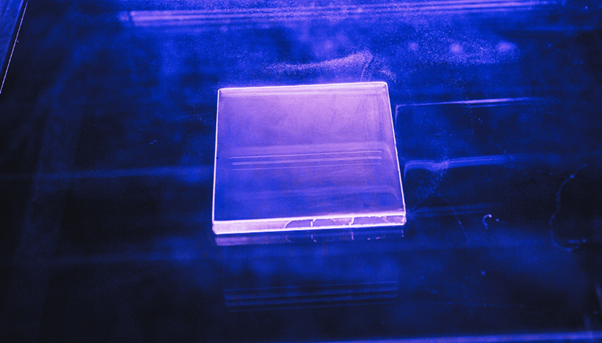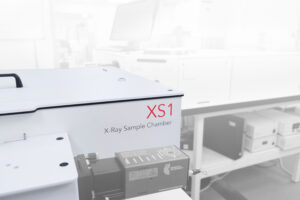This Research Highlight presents results from “Surfactant-Dependent Bulk Scale Mechanochemical Synthesis of CsPbBr3 Nanocrystals for Plastic Scintillator-Based Xray Imaging”, published in ACS Applied Nano Materials. Researchers from the University of Surrey synthesised metal-halide perovskite nanocrystals loaded into plastic discs for their application as X-ray sensors. Steady-state and time-resolved radioluminescence emission was acquired on an Edinburgh Instruments FLS1000 Spectrometer equipped with an XS1 Radioluminescence chamber. The discs produced a radioluminescence band at 536 nm with a lifetime of 29.4 ns.
Scintillators are materials that convert X-rays into UV or visible radiation for detection with a photodetector or imaging sensor. Such materials are in high demand for a diverse range of applications, including medical imaging, security checks, and scientific research. Metal halide perovskites such as CsPbBr3 nanocrystals (NCs) have attracted attention due to their bright radioluminescence (RL), high X-ray absorbance, and low detection limit.
This Research Highlight presents a study published in 2023 in ACS Applied Nano Materials by researchers at the University of Surrey.1 The scintillation properties of CsPbBr3 NCs were characterised with an Edinburgh Instruments FLS1000 Photoluminescence (PL) Spectrometer equipped with the XS1 RL chamber.
Batches of CsPbBr3 NCs were synthesised with different volumes (0.0, 0.05, 0.1, 0.2, 0.4, 0.8 mL) of an oleylamine (OAM) surfactant and were named accordingly (OAM 0.0, OAM 0.4 etc.). NCs were then loaded into poly(methyl methacrylate) (PMMA) plastic discs at a range of concentrations (1, 2, 4, and 10%). RL emission of the CsPbBr3 NCs / PMMA discs was measured with an FLS1000 spectrometer and XS1 RL chamber (Figure 1). Steady-state RL emissions of the samples were measured under excitation by a 60 kV X-ray with a tube current of 100 µA. Time-resolved RL decays were acquired using TCSPC with a laser-excited 40 kV pulsed X-ray source.
Figure 1: Edinburgh Instruments XS1 RL chamber.
The scintillation properties of the discs were characterised in the XS1 and are shown in Figure 2. A 4% OAM 0.4-loaded PMMA disc (PMMA OAM 0.4) produced an emission band at 536 nm (Figure 2a). It was found that RL intensity of the discs increased with both OAM concentration (Figure 2b) and NC loading (Figure 2c).
The RL decay of the 4% CsPbBr3 NC/PMMA disc was measured using a pulsed X-ray source, revealing a triexponential decay with an average RL lifetime of 29.4 ns (Figure 2d), which is significantly faster than commercial scintillators such as CsI:Tl (∼680 ns decay time).
Figure 2: (a) RL emission spectrum of PMMA disc loaded with 4% OAM 0.4. (b) Plot of RL emission against OAM volume for CsPbB3 NC/PMMA disc. (c) Plot of RL emission against NC loading of PMMA discs. (d) RL lifetime decay and fitting of a 4% CsPbBr3 NC/PMMA disc. The image is reprinted from Ghosh et al.1, Copyright (2024), with permission from American Chemical Society.
In this Research Highlight, it was shown how the FLS1000 equipped with the XS1 RL chamber can be used to characterise novel scintillator materials. The intensity of RL emission of the scintillators could be tuned with the surfactant concentration and NC loading. The materials exhibited a maximum RL emission band at 536 nm with a rapid lifetime of 29.4 ns, demonstrating its ability to act as an X-ray detector.
1. Ghosh, J. et al. Surfactant-Dependent Bulk Scale Mechanochemical Synthesis of CsPbBr3 Nanocrystals for Plastic Scintillator-Based X-ray Imaging. ACS Appl. Nano. Mater. 6, (2023).
The full article was published in ACS Applied Nano Materials. It is available at: Surfactant-Dependent Bulk Scale Mechanochemical Synthesis of CsPbBr3 Nanocrystals for Plastic Scintillator-Based X-ray Imaging.


